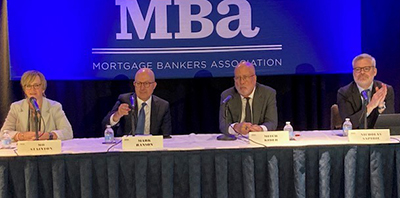
MBASecondary23: ESG ‘Here to Stay’

((l-r) Martha-Rosalind Stainton (Potomac Point Group), Mark Hanson (Freddie Mac), Mitch Kider (Weiner Brodsky Kider PC) and Nicholas Sapirie (Fannie Mae) at #MBASecondary23 in New York.)
NEW YORK–ESG–Environmental, Social and Governance—has evolved over the years. Many industries have embraced it; some politicians have decried it as anti-free market.
But ESG is quickly moving from a buzzword to a priority topic across industries, regulators and the capital markets.
Panelists here at the Mortgage Bankers Association’s National Secondary Market Conference & Expo discussed latest developments, including the GSEs social index and social bonds; and challenges companies may face when striving to meet ESG objectives.
“Sometimes the very definition of ‘ESG’ raises more questions than answers,” said Martha-Rosalind Stainton, founding partner of the Potomac Point Group, Washington, D.C. “Regardless, the concepts behind ESG are arguably here to stay. It may be hard to define, but it’s very real.”
“ESG is really a set of non-financial values,” said Mitch Kider, Chairman and Managing Partner of Weiner Brodsky Kider PC, Washington. “Unfortunately, you’re not going to get a lot of consistency, because there isn’t a lot of data there…you have a lot of apples and oranges that can’t be measured against each other.”
Affordable housing, for example, falls under the “Social” in ESG. “I like the concept; it’s about knowledge,” Kider said. “I also like it from the mortgage banking perspective, because lenders want to know where the next loan is coming. We’re really in the infancy of it all, but it is here to stay.”
“Freddie Mac started in earnest about three years ago to improve our disclosures,” said Mark D. Hanson, senior vice president of Securitization in the Freddie Mac Single-Family Portfolio and Servicing Division. “The first thing we did as a company was to perform a materiality assessment, and from there we focused on where we wanted to move the direction of our company. In our case, it starts with the lending community and our borrowers and extends through our investors. It’s all about our performance—not just our financial numbers, but what kind dent we’re leaving on the environment.”
“ESG provides all kinds of opportunities—how to make housing more efficient, what kind of environmental footprint we are leaving,” Hanson added. “Our focus is on how we do this in a more compliant way—and satisfy our investors.”
“We started issuing green bonds in 2010 and eclipsed the $100 million mark recently,” said Nicholas Sapirie, Vice President Single-Family Capital Markets with Fannie Mae, Washington. “It’s fairly easy to demonstrate how a structure meets certain environmental requirements, and much of our issuance has been in multifamily.”
The challenge for Fannie Mae has been on the Social element. “We’ve had a lot of feedback from investors that there is support for our social activities, but there are a number of challenges, such as the many different perspectives on the topic,” Sapirie said. “You can’t make everyone happy. The way we’ve been approaching this is finding ways to provide data in which our investors can feel confident.”
Additionally, Sapirie said, “we’re trying to incent lenders financially to make these kind of loans.”
“Our job, as large GSEs, is to find the ‘sweet spot’ that makes these kinds of loans more desirable for lenders and investors,” Hanson said. “
Standardization remains an issue as well. MISMO, a wholly owned subsidiary of the Mortgage Bankers Association, has an ESG Workgroup that is working on providing some standards for ESG products. But full standardization remains elusive, Kider said.
“As the industry evolves and matures, regulators will probably mandate how ESG standards are disclosed,” Kider said.
“Many standards equal no standards,” Stainton said.
